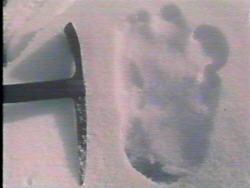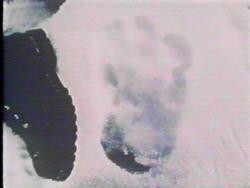Bigfoot Encounters
 These
are photographs of probably the most famous of the elusive yeti footprint
to date.
These
are photographs of probably the most famous of the elusive yeti footprint
to date.
Eric Shipton photographed and sketched this single track of an alleged
yeti, which measured 13 inches toe to heel. The footprint was found in
1951 on Menlung Glacier.
Additional yeti tracks similar in shape to Shipton's came along about
the same time: Lord John Hunt, Sir Edmund Hillary, Frank Smythe, H.W.
Tilman, and Peter Byrne who found a string of tracks in 1948 on one of
his first expeditions near the area of the Zemu Glacier at an altitude
of 15,000 feet.  None
of these tracks resembled the imprint in snow of the local brown bears,
- - bear tracks show claws, presumably the yeti does not. At least Shipton's
photograph show no claws and Byrne mentions no claws.
None
of these tracks resembled the imprint in snow of the local brown bears,
- - bear tracks show claws, presumably the yeti does not. At least Shipton's
photograph show no claws and Byrne mentions no claws.
In
1957, after spending 3 months trekking up Nepal's Arun River Valley on
a recon mission for a future expedition with Tom Slick, Peter Byrne found
a set of yeti footprints in the Chhoyang Khola at 10,000 feet altitude.
The prints were identical to those Byrne had seen previously in Sikkim
years earlier. They were ten inches in length and of similar construction.
Slick, working with a separate party in another area found a second set
of footprints, these were 13 inches in length.
The newly discovered footprints, presumably those of the yeti, were 5
toed, ten to thirteen inches in length and of a bipedal creature of considerable
weight.
There must be some basis in fact behind the many reports, photographs
etc of these unusual tracks. As we say in North America, .."something
is leaving large, unusual barefoot human-like tracks."
It may be considered irresponsible for alpinists to assume the yeti is
merely a bear when you consider the number of tracks found that do not
have claws and are otherwise dissimilar in construction to those of the
local bear population. ...Bobbie
Short
Back to Creatures?
Main